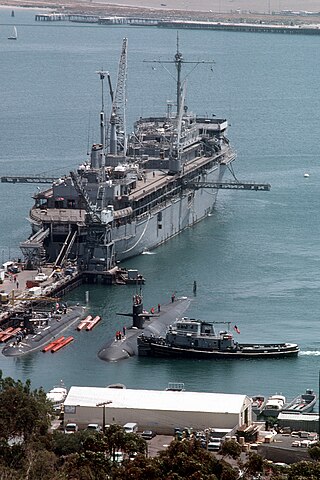USS Yuma has been the name of five ships of the United States Navy. The name is taken after the Yuma tribe of Arizona.
Five ships of the United States Navy have been named Catawba, after the Catawba River of North Carolina.
Three ships in the United States Navy have been named USS Saco for the Saco River and for the Saco, Maine.
Three ships in the United States Navy have been named USS Cayuga for one of the six Iroquois tribes.

The first USS Talbot was a torpedo boat in the United States Navy.
The Choctaw are a Native American people.

USS Pawtucket, was a district harbor tug serving in the United States Navy in the early 20th century, during both World War I and World War II. This was the first of two US Navy namesakes of the city of Pawtucket, Rhode Island, and the Native American tribe bearing the same name.

USS Hannibal (AG-1) was launched 9 March 1898 as the 1,785 GRT steamer Joseph Holland of London. The ship was laid down at as North Dock yard hull 143 for F. S. Holland, London, by J. Blumer & Company at Sunderland, England. Completion was in April 1898.
USS Resolute may refer to the following ships operated by the United States Navy:

USS Mohave (AT-15) was a Arapaho-class fleet tug of the United States Navy. The unnamed steel-hulled Fleet Tug No.15 was laid down on 16 December 1913 by the Seattle Construction and Drydock Company. She was named Mohave in accordance with General Order No. 97 of 9 May 1914, for the Yuman tribe on the Colorado River in Arizona, California, and Nevada. Launched on 20 June 1914; and placed in service at the Puget Sound Navy Yard, Bremerton, Washington, on 2 December 1914.

USS Concord (SP-773), later known as USS Mendota (YT-33) and again later as USS Muscotah (YT-33) was a tugboat acquired by the U.S. Navy during World War I. Concord was initially assigned to North Atlantic towing duties, and later was assigned as harbor tug at the Washington Navy Yard. She was sold in 1937.

Washtucna (YTB-826) was a United States Navy Natick-class large harbor tug named for Chief Washtucna of the Palus tribe.

USS Maple, was a lighthouse tender that served in the United States Navy from 1893 to 1899, seeing service as an auxiliary ship during the Spanish–American War in 1898, and from 1917 to 1919, operating as a patrol vessel during World War I. She also served as USLHT Maple in the United States Lighthouse Board fleet from 1899 to 1910 and in the United States Lighthouse Service from 1910 to 1933.
The first USS Apache, later USS Aspinet (YF-176), was a United States Navy tug in commission during 1898, which then served again as a freight lighter from 1900 to 1925.

The second USS Choctaw was a yard tug in the United States Navy from the Spanish–American War to World War II. She was renamed USS Wicomico in 1918.
USS Vigilant may refer to several ships of the United States Navy:

USS Active was a tug constructed in 1888 at San Francisco by the Union Iron Works. The tug, first steel tug built on the West Coast, was launched 4 August 1888. She was acquired by the United States Navy from John D. Spreckels Brothers Co. on 18 April 1898 "for auxiliary purposes incident to a state of war." Converted for naval service at her builder's yard, she was commissioned at the Mare Island Navy Yard on 6 July 1898. She was the third US Navy ship to be named Active.

USNS Choctaw County (JHSV-2/T-EPF-2), (ex-Vigilant) is the second Spearhead-class expeditionary fast transport, which is operated by the United States Navy's Military Sealift Command and was built in Mobile, Alabama.

USS Choctaw (AT-70) was a Navajo-class fleet tug constructed for the United States Navy during World War II. Her purpose was to aid ships, usually by towing, on the high seas or in combat or post-combat areas, plus "other duties as assigned." She served in Bermuda during the end of World War II where she was primarily responsible to aiding in the assembly of convoys and ships taking part in training. On 15 May 1944, she was redesignated ATF-70. She continued to serve for 3 more years before being decommissioned on 11 March 1947.
This page is based on this
Wikipedia article Text is available under the
CC BY-SA 4.0 license; additional terms may apply.
Images, videos and audio are available under their respective licenses.










